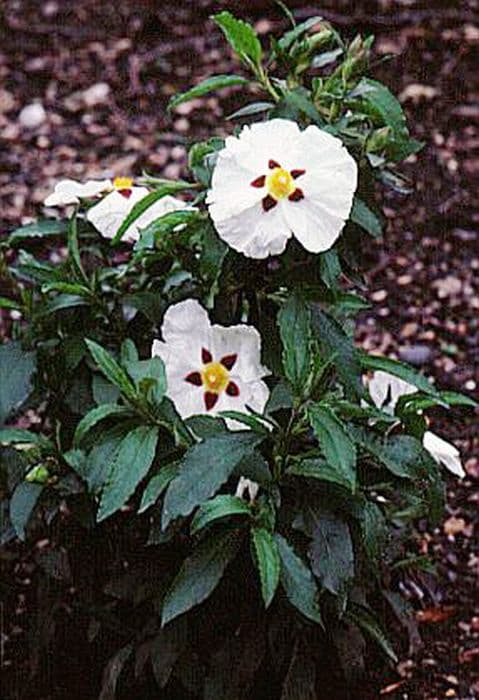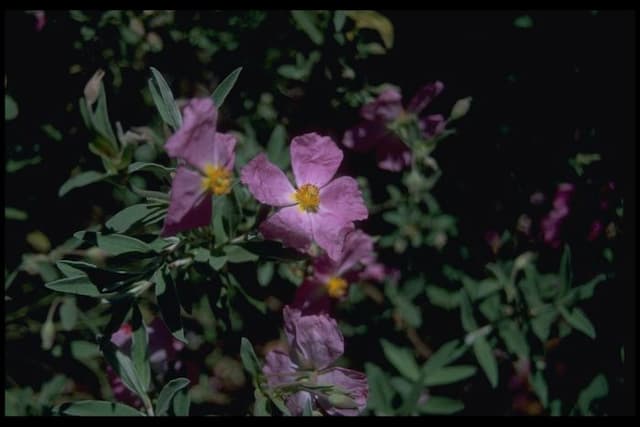Woolly Rockrose Halimium lasianthum

ABOUT
Halimium lasianthum, commonly known as woolly rockrose, is a striking plant known for its ornamental features. The plant has a growth habit that forms dense shrubby mounds covered with small, dark green leaves. The foliage of the woolly rockrose presents a slightly fuzzy texture that adds to its unique appeal. Flourishing in bloom, woolly rockrose displays an abundance of showy flowers that add a splash of color to gardens and landscapes. These blooms are particularly eye-catching, with five-petaled flowers that are a vibrant shade of yellow, offering a bright contrast against the darker green leaves. Each petal might also feature a subtle yet appealing red or maroon mark at the base, creating a stunning visual effect. The flowers typically have a saucer-like shape and may exhibit a delicate papery texture. The overall appearance of woolly rockrose is one of rustic charm and resilience, making it well-suited for ornamental use in a variety of garden settings where its brilliant flowers can be showcased to great effect.
About this plant
 Names
NamesFamily
Cistaceae
Synonyms
Woolly Rockrose, Gum Rockrose
Common names
Cistus lasianthus, Halimium lasianthum subsp. alyssoides, Halimium lasianthum subsp. lasianthum, Halimium alyssoides.
 Toxicity
ToxicityTo humans
Rockrose is not commonly reported as a toxic plant to humans. Therefore, no specific symptoms of poisoning or toxicity for ingestion by humans are well-documented. However, like with any plant, individual allergies or sensitivities can occur, and it's generally a good practice to avoid ingesting parts of plants not known to be edible or which haven't been properly identified and deemed safe by experts.
To pets
Rockrose is similarly not commonly reported as toxic to pets. There are no well-documented cases or studies showing specific symptoms of poisoning from pets ingesting this plant. Still, it is best to prevent pets from eating plants that are not part of their normal diet, as any plant material can potentially cause gastrointestinal upset or an adverse reaction in some animals.
 Characteristics
CharacteristicsLife cycle
Perennials
Foliage type
Evergreen
Color of leaves
Green
Flower color
Yellow
Height
3 feet (0.9 meters)
Spread
3 feet (0.9 meters)
Plant type
Shrub
Hardiness zones
7
Native area
Mediterranean
Benefits
 General Benefits
General Benefits- Ornamental Value: Halimium lasianthum, commonly known as Rockrose, is appreciated for its decorative flowers and is widely used in gardening and landscaping for aesthetic purposes.
- Drought Tolerance: Rockrose is highly resistant to dry conditions, making it an excellent choice for xeriscaping and gardens in arid climates.
- Low Maintenance: It requires minimal care once established, which makes it a convenient option for gardeners seeking low-maintenance plants.
- Soil Stabilization: The plant's root system helps to stabilize soil and prevent erosion, especially in sandy or loose soil areas.
- Habitat Support: Provides habitat and food for pollinators like bees and butterflies, contributing to biodiversity.
- Fire Resistance: Rockrose is known to be fire-retardant and can be part of fire-resistant plantings in wildfire-prone areas.
- Fast Growth: The plant grows relatively quickly, which can be advantageous for creating coverage or achieving a mature garden look in a short period.
- Deer Resistance: Has a degree of resistance to browsing by deer, making it suitable for gardens in areas with deer populations.
 Medical Properties
Medical Properties- Anti-inflammatory: Halimium lasianthum is sometimes used in traditional medicine for its potential anti-inflammatory properties.
- Antioxidant: Extracts from the plant have been studied for their antioxidant activity, which may help to protect cells from damage.
 Air-purifying Qualities
Air-purifying QualitiesThis plant is not specifically known for air purifying qualities.
 Other Uses
Other Uses- Halimium lasianthum, commonly known as rockrose, can be used for ornamental purposes in xeriscaping and rock gardens due to its drought tolerance and attractive flowers.
- The plant can provide habitat and food for wildlife; its flowers are a food source for bees and other pollinators.
- Fiber from the plant can be utilized in the production of paper or textiles, though this is not a common use.
- Rockrose can be planted as a ground cover for erosion control on slopes and in areas prone to land degradation.
- The plant produces a resin known as labdanum, which historically has been used in perfumes and incense.
- Rockrose is suitable for bonsai cultivation, offering an interesting challenge for enthusiasts due to its small leaves and flowering nature.
- The dense nature of Halimium lasianthum can also make it a natural privacy screen or windbreak in landscape design.
- The wood from Halimium lasianthum, like many other shrubs, can be used in the creation of small wooden objects or as kindling.
- The plant has been used in traditional dye-making processes, utilizing its parts to produce natural colors.
- As a cultural symbol, rockrose sometimes features in garden designs that aim to reflect the Mediterranean landscape and ethos.
Interesting Facts
 Feng Shui
Feng ShuiThe Halimium is not used in Feng Shui practice.
 Zodiac Sign Compitability
Zodiac Sign CompitabilityThe Halimium is not used in astrology practice.
 Plant Symbolism
Plant Symbolism- Resilience: Halimium lasianthum, commonly known as rockrose, often grows in tough, rocky areas, symbolizing the ability to endure and thrive in challenging conditions.
- Beauty in Simplicity: The rockrose's modest yet attractive appearance represents the beauty that can be found in simple, unpretentious things.
- Rebirth and Renewal: As a plant that is often found in fire-prone areas and can regenerate after wildfires, the rockrose symbolizes rebirth and the start of new beginnings following hardship or destruction.
 Water
WaterThe rockrose should be watered moderately, ensuring the soil is dry between waterings. During the growing season, typically spring and summer, water it every one to two weeks with about 1-2 gallons, depending on the size of the plant and the dryness of the soil. In the fall and winter months, reduce watering to every two to three weeks as the plant enters a dormancy period. It's important to avoid over-watering which can lead to root rot.
 Light
LightRockrose thrives best in full sun conditions, so it should be planted in a spot where it receives at least six to eight hours of direct sunlight daily. The ideal location is one that offers bright, unfiltered sunlight throughout the day, such as a south-facing garden. While the plant can tolerate some light shade, too little light can inhibit flowering and lead to leggy growth.
 Temperature
TemperatureRockrose prefers warm temperatures and is hardy in USDA zones 7 through 10, which allows it to handle temperatures as low as 0 to 10 degrees Fahrenheit. However, it grows best when daytime temperatures are between 60 and 80 degrees Fahrenheit. The plant can withstand brief periods of cold down to about 10 degrees Fahrenheit, but sustained freezing temperatures can damage or kill the plant.
 Pruning
PruningRockrose benefits from pruning to maintain its shape and promote healthy growth. Prune in late winter or early spring, before new growth begins, to remove any dead or damaged branches and to shape the plant. Pruning can be done annually, but it's also acceptable to prune every two to three years, depending on the desired size and shape of the plant. The best time for pruning is immediately after the blooming period to encourage new flower buds for the next season.
 Cleaning
CleaningAs needed
 Soil
SoilThe woolly rockrose (Halimium lasianthum) thrives in well-draining, sandy or loamy soil with a slightly acidic to neutral pH range of 5.5 to 7.5. A good soil mix for this plant would be one part sandy loam, one part peat, and one part perlite or coarse sand to ensure proper drainage and aeration.
 Repotting
RepottingWoolly rockrose (Halimium lasianthum) does not require frequent repotting and can be done every 2-3 years. It's best to repot in the spring just before new growth begins, using a suitable well-draining soil mix.
 Humidity & Misting
Humidity & MistingWoolly rockrose (Halimium lasianthum) is drought-tolerant and prefers a dry to moderate humidity level. It is well adapted to the typical humidity found in Mediterranean climates and does not require high humidity.
 Suitable locations
Suitable locationsIndoor
Place woolly rockrose in bright light, well-draining soil, and water sparingly.
Outdoor
Plant woolly rockrose in full sun, well-draining soil, and water occasionally.
Hardiness zone
8-10 USDA
 Life cycle
Life cycleHalimium lasianthum, commonly known as woolly rockrose, begins its life cycle with germination, which occurs when environmental conditions such as temperature and moisture are favorable, allowing the seeds to sprout. The seedlings then grow, establishing their root systems and developing their first true leaves through the vegetative stage. As the plants mature, they enter the flowering stage, typically in the spring and summer, where they produce yellow flowers that are pollinated by insects. Following pollination, the flowers develop into fruit, which are capsules containing seeds. These seeds are dispersed by various means, including wind and animal movement, and can remain dormant in the soil until conditions are right for the next generation to germinate. Throughout its life, Halimium lasianthum adapts to the Mediterranean climate and can withstand drought conditions, completing its life cycle over several years as a perennial shrub.
 Propogation
PropogationPropogation time
Spring to Summer
Halimium lasianthum, commonly known as woolly rockrose, is typically propagated via seed or semi-hardwood cuttings. The most popular method involves taking semi-hardwood cuttings during the summer months. To do this, select a healthy, non-flowering shoot and cut a 4 to 6-inch (10 to 15 centimeters) length. The base of the cutting should be dipped in rooting hormone before being placed in a pot filled with a well-draining soil mix. The cutting should then be kept in a warm, bright area, out of direct sunlight, with consistent moisture to encourage rooting. After several weeks, roots will develop, at which point it can gradually acclimate to more sunlight before being transplanted into the garden.









